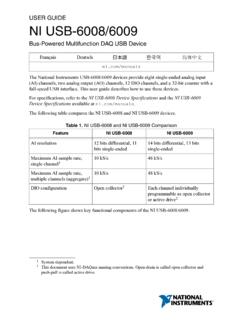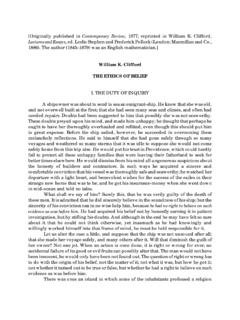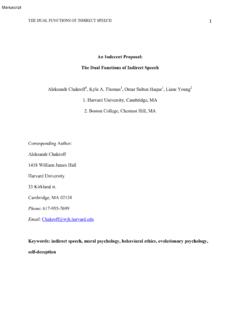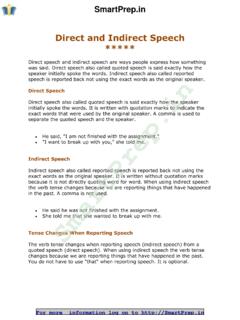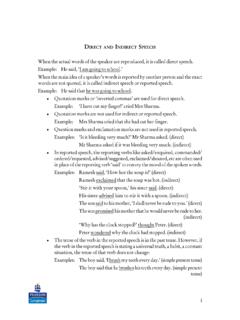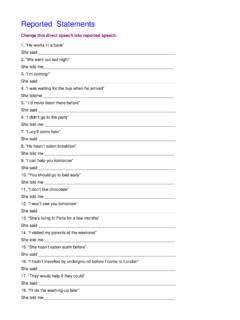Transcription of Searle 1975 Indirect Speech Acts - Brandeis University
1 Searle 1975 . Indirect Speech Acts Aaron Braver Ling 140a 9 February 2007. Introduction There are several cases of meaning: (1) Cases in which the speaker means what he says and nothing more (2) Cases in which the speaker means what he says, but also means some- thing more a. I want you to do it - meant as both a statement, but primarily as a request, by way of making a statement (3) Cases in which the speaker means what he says, but also means another illocution with different propositional content a. Can you reach the salt? - meant not merely as a question, but also as a request to pass the salt In (2), the second illocution is the same as the original proposition, but in (3). this is not the case. Searle suggests a pattern of analysis for cases of the type in (3) - but does not lay out a full-scale theory.
2 The utterance in these cases is meant as a request, the speaker (S) intends for the hearer (H) to know that, and intends to do so by getting the hearer to recognize that intention. The utterance has two illocutionary forces - one illocutionary act is per- formed by way of performing another. Searle proposed earlier (1969) that these types of utterances can be understood in terms of the conditions required for them to be performed felicitously. He expands further on that notion in this paper. The apparatus necessary to explain Indirect Speech acts includes a theory of Speech acts and general principles of cooperative conversation ( Grice). In some cases, convention plays a role as well. 2. ( Searle 1975 ). Indirection: A Sample Case The utterance of (4b) below normally serves as a rejection of the proposal, but clearly not by virtue of its meaning: (4) a.
3 Student X: Let's go to the movies tonight b. Student Y: I have to study for an exam Statements of the form of (4b) do not generally constitute rejections of propos- als, even if they come immediately after a proposal. If Student Y had responded to the proposal with (5) instead, it would not normally be interpreted as a re- jection: (5) Student Y: I have to brush my teeth The question, then, is how does Student X know that (4b), but not (5) is a rejection of his proposal? Some terminology: The secondary illocutionary act of a given utterance is the literal meaning of that utterance (above, that Y has to prepare for an exam). The primary illocutionary act of a given utterance is the act per- formed by way of the secondary illocutionary act (above, in having said that he needs to prepare for an exam, Y rejects X's proposal).
4 We can now re-word the question: How does X understand the nonliteral primary illocutionary act from understanding the literal secondary illocu- tionary act? This is part of the larger question of how Y means the primary illocution when he only utters a sentence that means the secondary illocu- tion. Steps in reconstructing the derivation of the primary illocution in (4b): Step 1 I have made a proposal to Y, and in response he has made a statement to the effect that he has to study for the exam (facts about the conversation). Step 2 I assume that Y is co operating in the conversation and that therefore his remark is intended to be relevant (conversational co operation, Grice). Step 3 A relevant response must be one of acceptance, rejection, counterpro- posal, further discussion, etc (theory of Speech acts, not yet expounded).
5 Step 4 But his literal utterance was not one of these, and so was not a relevant response (inference from Steps 1 and 3). Step 5 Therefore, he probably means more than he says. Assuming his remark is relevant, his primary illocutionary point must differ from his literal one (inference from Steps 2 and 4) - this is a crucial step, which allows Y to figure out that the primary illocutionary point is not the same as the literal one. 3. ( Searle 1975 ). Step 6 I know that studying for an exam normally takes a large amount of time relative to a single evening, and I know that going to the movies normally takes a large amount of time relative to a single evening (factual background information). Step 7 Therefore, he probably cannot both go to the movies and study for an exam in the same evening (inference from Step 6).
6 Step 8 A preparatory condition on the acceptance a proposal, or on any other commissive, is the ability to perform the act predicated in the propositional content condition (theory of Speech acts). Step 9 Therefore, I know that he has said something tha thas the consequence that he probably cannot consistently accept the proposal (inference from Steps 1, 7, and 8). Step 10 Therefore, his primary illocutionary point is probably to reject the proposal (inference from Steps 5 and 9). These steps can be summarized as follows. First, establish that the primary illocutionary point departs from the literal. Second, establish what the primary illocutionary point is. Conventional Performatives in Indirect Directives Some sentence-structures are quite standardly used to make Indirect requests.
7 On a first pass, they naturally fall into six groups: Group 1 Sentences concerning H's ability to perform an action (A): Can you pass the salt? You could be a little more quiet. Have you got change for a dollar? Group 2 Sentences concerning S's wish or want that H will do A: I would like you to go now. I wish you wouldn't do that. I'd rather you didn't do that. Group 3 Sentences concerning H's doing A: Officers will henceforth wear ties at dinner. Won't you stop making that noise? Will you quit it? Group 4 Sentences concerning H's desire or willingness to do A: Would you be willing to write me a letter of recommendation? Would it be con- venient for you to come on Wednesday? Group 5 Sentences concerning reasons for doing A: You ought to be more polite. Why don't you be quiet?
8 We'd all be better off if you'd just pipe down. Group 6 Sentences embedding one of these elements inside one another, or embedding an explicit directive illocutionary verb inside one of these ele- ments: Would you mind awfully if I asked you if you could write me a letter of recommendation? I would appreciate it if you could make less noise. 4. ( Searle 1975 ). Observations About Conventional Performatives Searle notes several salient facts about these sentences, which hold in a prethe- oretical sense. Fact 1 : The sentences in question do not have an imperative force as part of their meaning. Fact 2 : The sentences in question are not ambiguous as between an imperative illocutionary force and a nonimperative illocutionary force. Fact 3 : Notwithstanding Facts 1 and 2, these are conventionally used to issue directives.
9 There is a systematic relation between these and directive illo- cutions in a way that does not exist between I have to study for an exam and rejecting proposals. Fact 4 : The sentences in question are not, in the ordinary sense, idioms. When using one of these sentences as an Indirect directive, they still ad- mit a literal response. Also, when translated word-for-word into other languages, they often still have the same Indirect illocutionary force as in English. Fact 5 : To say they are not idioms is not to say they are not idiomatic. They are used idiomatically in their role as Indirect Speech acts. Fact 6 : The sentences in question have litteral utterances in which they are not also Indirect requests. The intonation, though, may vary between these readings. Fact 7 : In cases where these sentences are uttered as requests, they still have their literal meaning and are uttered with and as having that literal mean- ing.
10 What is added in Indirect Speech acts is not any additional or different sentence meaning, but rather additional speaker meaning. Fact 8 : It is a consequence of Fact 7 that when one of these sentences is uttered with the primary illocutionary point of a directive, the literal illocutionary act is also performed. You can see this in that a subsequent report of the utterance can truly report the literal illocutionary act. The Theory of Speech Acts One way to look at both types of Indirect Speech acts is by examining the set of conditions necessary for the felicitous performance of the act. 5. ( Searle 1975 ). (6). Directive and Commissive Felicity Conditions Condition Directive (request) Commissive (promise). Preparatory H is able to perform A S is able to perform A. He wants S to perform A.


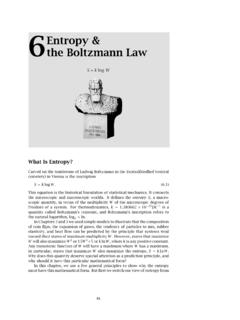


![LINEAR ALGEBRA MIDTERM [EXAM A] - Brandeis University](/cache/preview/2/a/5/a/8/6/f/b/thumb-2a5a86fbead498bbe4749596c75df645.jpg)
